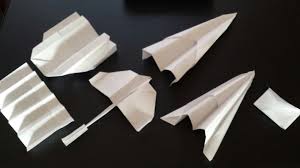Avion en papier
Origami Instructions Free Online Picture also shows the results graphically of moving away from the 'purest' form of Origami in each one of the eight directions. In some cases I use marked the art as 'open-ended', for example paper-cuts.
Origamie facile
By this I mean that we will no longer have a shut system typical of Origami where a procedure exists to create a model and can return to the starting point. It is arguable it is the closed-system through which can some- how break, which is real characteristic of Origami. ShapingRegular figures such as triangles, pentagons are well established for Origami.
Origami facile
Kent du Pre has done Avion En Papier Propulsé such work on Symmetric figures such as stars from which flowers can be collapsed. Irregular figures have made an appearance occasionally, however the most extreme form only occurs in Paper Magic with Rolf Harris's models. Silhouettes have no restrictions in the Origami sense and are of course strongly related to paper cutting. In its simplest form cuts are made prior to folding in a symmetric and planned way which will 'open up' the fabric available without the need for excessive width. The most recent point out of the techniques is by Toshie Takahama who refers to it as Kirikomi and distinguishes it as typical of very early Origami Flower Ball Japanese Origami.
Origami fleur
Uchiyama is reported as acquiring a patent in 1908 for 'KOKO'. style origami which appears to be the same in principle. Japanese books are packed with slitting to achieve ear or a tail or even legs. Perhaps one of the most famous examples of theme 'slits to avoid folding' is in Fred Rohm's Circus pony in which 2 cuts are made, one for the ears and the other to offer enough points for the legs. Rohm folded his Circus pony without cuts but the technique is then much more complex. Thus we have 2 motives for cutting appearing here; one to create new opportunities and Origami Star 3d the other to avoid the complexities of a model achieved solely by folding.
Fleur en papier
The slicing out of holes and so forth. to indicate eyes and so forth is sometimes found in Japanese books and we are obviously dealing with a technique which is becoming open-ended. When we fold in a symmetric way to prepare our paper for cutting the folding has obviously become secondary (2). Honda has called this kind of paper-craft Mon-Kiri (which means crest-making). The particular last step in the slitting or cutting is paper-cutting, some of the finest examples are likely from China and evidently here we have an open-ended Talent. Supporting A Bateau En Papier Qui Flotte Sur L'eau way of moving away from the 'pure' central form is supporting or adding display mechanics to the models. In its simplest form organic beef use glue, staples or 'blue tac' to hold an auto dvd unit in the desired pose and position. Or we may use wiring or credit card. Probably the most unusual form of 'display mechanics' that I actually am familiar with is by Toyoaki Kawai.
Fleur origami
Inside a corner of the Sustenance Industry Pavilion at EXPO', electricity was used to make Origami pigeons flap their wings. Modelling This is now usual in animal folds to call for a final modelling particularly if foil has recently Bateau De Papier Chanson Hugues Aufray been used and one can make certain of the substance remaining in place. A contemporary example of this is in Pat Crawford's models. Neal Elias who probably led the move in the West to 3D insists on any modelling following the folding The technique of wetting the paper is apparently Japanese in origin was demonstrated by Yoshizawa at a Convention in Luton. Another method of moist moulding using paste in the preparation is discussed by Alice Gray the girl was shown it by Yoshizawa during a visit to Japan. The folds up tend to be soft and are approaching sculpture rather than Origami.
Comment faire un avion en

papier
Within the most extreme combos of water and papers we are, naturally , in the world of fun which is obviously an open-ended art. DecoratingThe easiest step from your single color is one side coloured and one white or plain. A great offer of modern Origami exploits this colour difference. A new delightful example is Mary Homewood's Robin. We can use the texture of our material which need not even be evade or paper. Neal Elias collects patterned foil and has shown models in 3 colours which rely after deciding on the best pattern and cutting his material to get the colour exactly where he Avion Den Papier wants them. A more restricted form of decoration occurs in Japanese papers which are already printed with a design suited to a unique model. The end of this process is evidently the decoration of the ultimate model and so into the decorative art proper which is open-ended. Lengthening Simply by stretching our square we obtain rectangles then bows and finally string.
Bateau en papier
The associated arts are Weaving and Macrame which are open-ended. However with string we can have 'Cats Cradles' which is a closed-systems game with direct analogie to Origami. Multi-layer Toshie Takahama has produced some superb examples of this variation of Origami. The particular sheets
Comentarios
Publicar un comentario